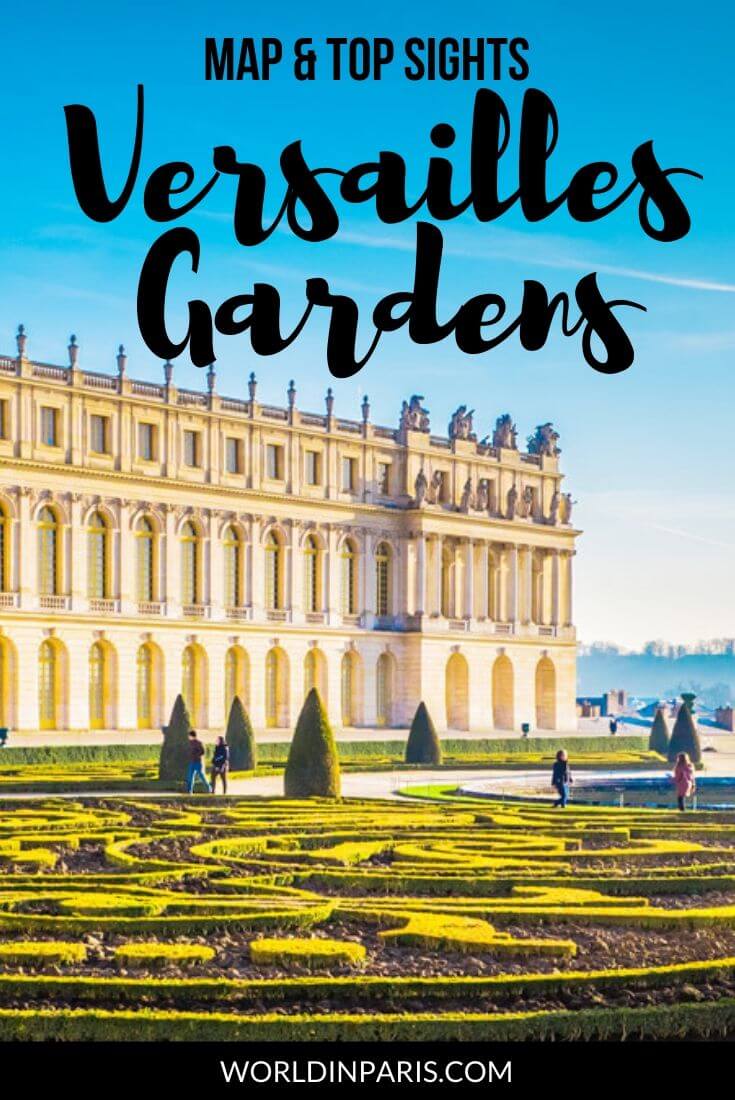Visit the Gardens at Versailles
The Gardens of Versailles are a key component of Château de Versailles. Arguably one of the most beautiful gardens in Ile-de-France (and the world!), the Gardens at Versailles are the perfect getaway from the hustle and bustle of Paris.
Most people visit the Versailles Gardens after the visit to the Palace of Versailles, already tired and without much time left. The truth is that the Gardens of Versailles are so beautiful, and with so many things to see and do, they can be a destination by themselves.
In this post, we tell you all about the Versailles Gardens: what to see and do, the history and the Versailles Garden shows. There’s also a Versailles map to help you pinpoint all the must-see spots.
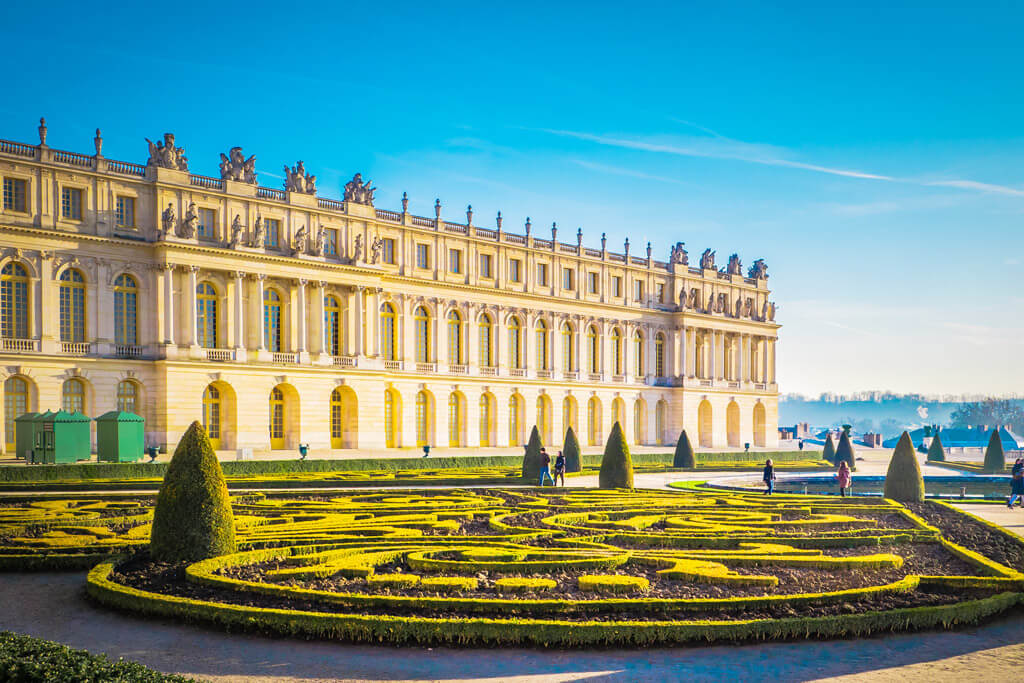
Table of Contents:
- Introducing the Versailles Estate
- Best Time to Visit Versailles Gardens
- Versailles Musical Gardens & Versailles Fountain Shows
- History of the Gardens of Versailles
- Versailles Gardens Map and Top Sights
Plan Your Trip to Versailles

Introducing the Versailles Estate
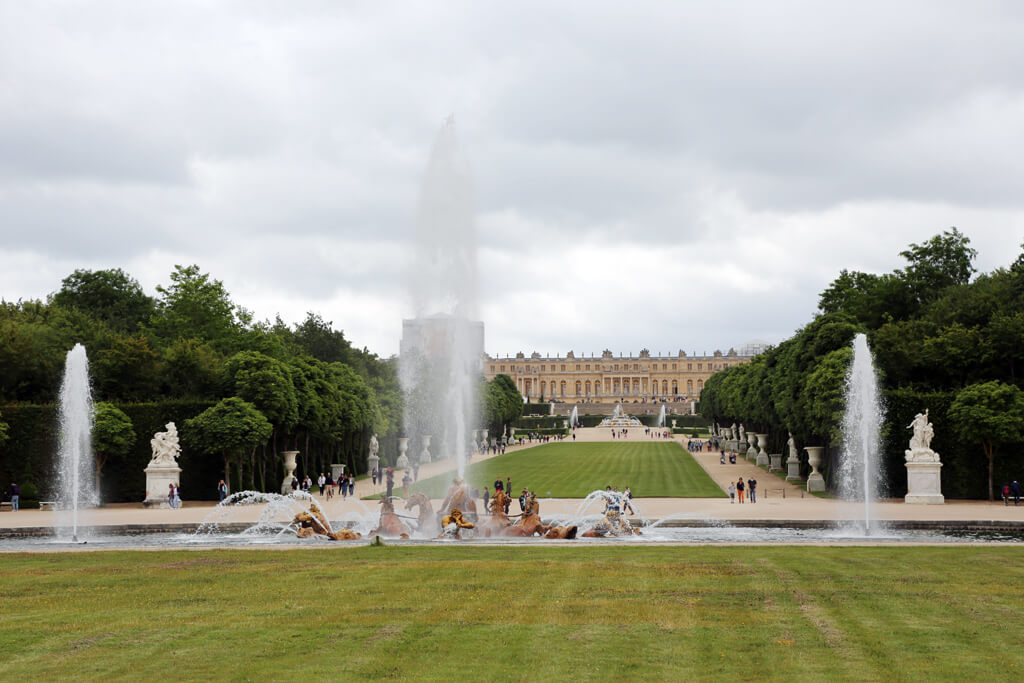
The Versailles Estate covers a surface of 800 Ha, and it is divided into different areas:
- Château de Versailles
- Trianon Palaces
- Hameau de la Reine – Queen’s Hamlet
- Formal Gardens (known as Le Petit Parc)
- The Grand Canal
- Forest (known as Le Grand Parc)
You can move through the different parts of Versailles by bike, except within the Petit Parc, where you can only walk or use the electric cars available for rent at the water parterres. There’s also a little train that tours the Versailles Estate.
Access to the Gardens of Versailles:
- From the Palace, through the Cour des Princes (on the left side of the Palace)
- From Boulevard de la Reine, through the Queen’s Fence, then the Neptune Fence (north)
- From the Grand Canal, through the Petite Venise Fence (east) and Ménagerie Fence (west)
This article covers only the formal Gardens of Versailles (Le Petit Parc), but you can navigate to other parts of the Versailles Estate from this post.
Best Time to Visit Versailles Gardens
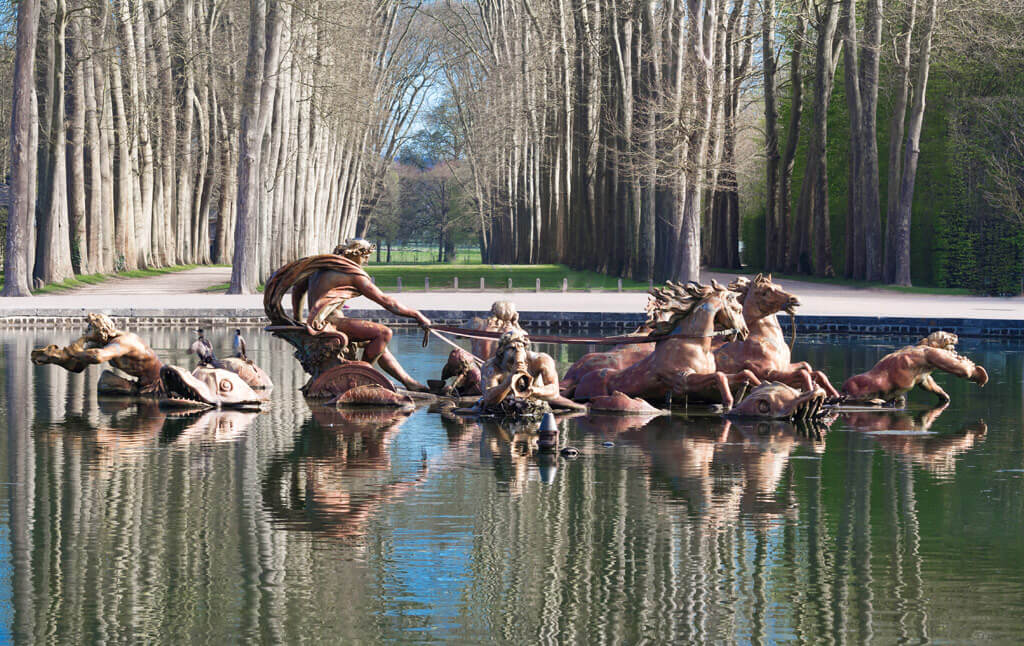
When is the best time to visit Versailles Gardens? Here’s an overview of the Gardens at Versailles by season.
- SPRING: first blooms in the Gardens of Versailles and lesser crowds.
- SUMMER: there are the Versailles Garden shows, with the fountains working. this is the high season in Versailles, when the grounds of Versailles see the crowds. The days are longer, the temperatures are higher, and visitors can enjoy the Versailles Garden Shows with the fountains working.
- FALL: it is the season of beautiful colors, fall foliage, and fewer crowds. Le Petit Parc is free to visit (from 1 November to 31 March), but some grooves are closed.
- WINTER: it is the low season, with fewer crowds but higher chances of rain in Versailles. Le Petit Parc is free to visit (from 1 November to 31 March), but some grooves are closed. The Versailles Gardens close earlier, usually at sunset.
TIP: Learn the history and admire the best of Versailles Gardens with this Gardens`Guided Walking Tour
Versailles Musical Gardens & Versailles Fountain Shows
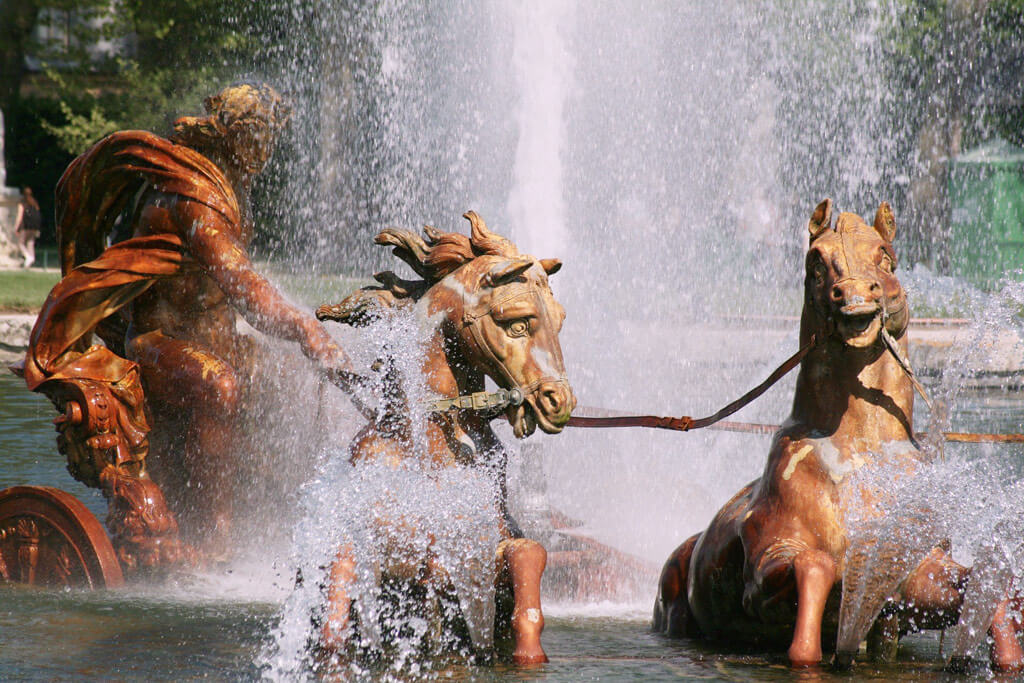
From April to the end of September, the Versailles Gardens are in full bloom, and all the grooves are open to visitors. During this time, visitors can enjoy various Versailles Garden shows: the Versailles Musical Gardens and Versailles Fountain Shows.
During the Versailles Garden shows, there’s an entrance ticket to the Gardens, and you can buy these tickets alone and visit Versailles Gardens only or in combination with other parts of the Versailles Estate (click here for the best Versailles bundles).
1. Versailles Fountain Shows
Explore the Versailles Gardens and Grooves while listening to Baroque music and watch the fountains’ water display with special effects – Buy your tickets to the Versailles Fountain Shows
Save money with this Versailles Palace & Gardens full-access ticket
Days:
- Every Saturday and Sunday from 1 April until 29 October.
- Every Tuesday from 2 May to 27 June.
- Friday 7 April, Monday 10 April, Monday 8 May, Ascension Day, Monday 29 May, Friday 14 July, and Tuesday 15 August.
2. Musical Gardens Show
Wander through the Gardens of Versailles while listening to the beautiful sounds of Baroque music. This show does not include the fountains’ water display – Buy your tickets to the Musical Gardens Show
Save money with this Versailles Palace & Gardens full-access ticket
Days:
- Every Tuesday, Wednesday, Thursday, and Friday from 4 April to 28 April
- Every Wednesday, Thursday, and Friday from 3 May to 30 June
- Every Tuesday, Wednesday, Thursday, and Friday from 4 July to 31 October
3. Night Fountains Show (Grandes Eaux Musicales)
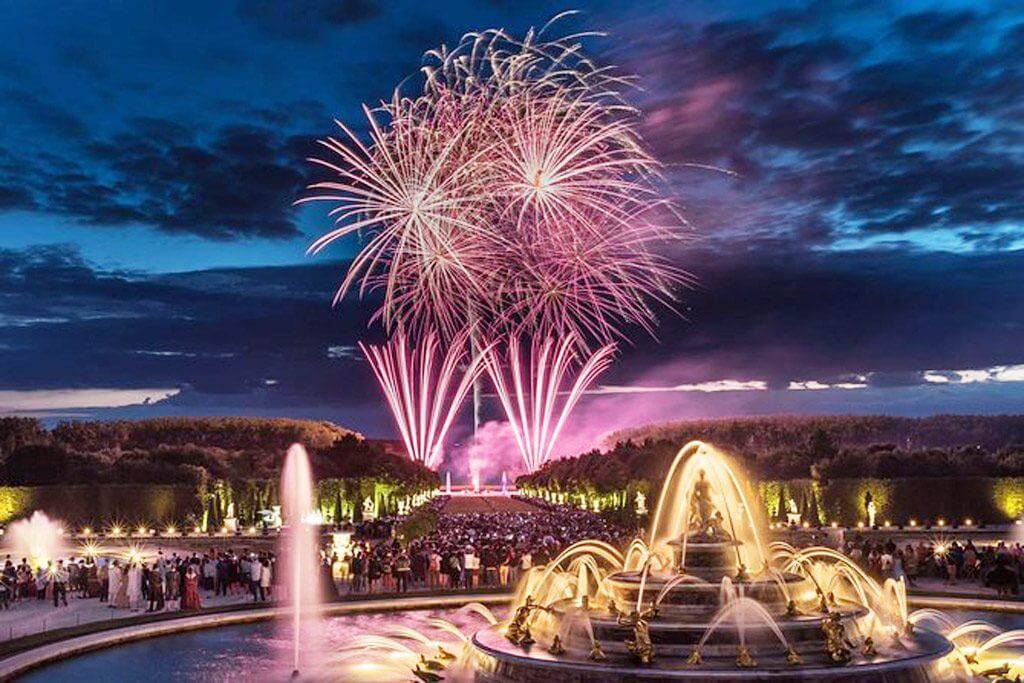
At night, fountains and groves come alive with colorful and dramatic lighting effects. The Night Fountains Show ends with a grand finale, a fireworks display in front of the Grand Canal – Buy your tickets to the Night Fountains Show
Dates:
- Every Saturday from 10 June until 23 September (08:30 pm to 11:05 pm)
- Friday 14 July, and Tuesday 15 August.
TIP: Transportation in Versailles after the Fountains Night Show is complicated. The last RER train to Paris runs until about midnight, a connection which is doable but very tight, especially because everybody waits until the end of the Grand Finale to leave the grounds. Avoid the hassle of running to catch the last (and hyper-crowded) train by booking a private transfer from Versailles to your hotel in Paris with Welcome Pickups. You can also decide to spend the night in one of the hotels near Château de Versailles and use the second day for exploring the city or a bike ride + picnic in the park.
History of the Gardens of Versailles

For King Louis XIV, the Gardens of Versailles were as important as the Royal Palace. That’s why, in 1661, he commissioned André Le Nôtre to design the Gardens’ layout and decoration.
André Le Nôtre was the most famous landscape designer of the time and creator of the French-style garden typology. Amongst his most famous works, we can find the gardens of Château de Chantilly, the gardens of Château de Vaux-le-Vicomte, or the Tuileries Gardens in Paris.
For such an important project, André Le Nòtre had the best team ever: Jean-Baptiste Colbert – superintendent of the King’s buildings – was in charge of the site and construction management; Charles Le Brun – the King’s First Painter – designed the statues and fountains. On top of them, there was King Louis XIV himself, who liked to supervise the works and all the details.
The works to build the most magnificent gardens out of a land occupied by meadows and marshes were titanic and lasted forty years. Thousands of men, sometimes even entire regiments, took part in this immense project.
But perhaps the main challenge was the water supply in a place far from any water source. To solve the problem, the King’s engineers invented the Machine de Marly, which transported water from the Seine River to Versailles through a network of wheels, pumps, pipes, and an aqueduct. At that time, the Machine de Marly was known as the Eighth World Wonder.
The Royal Promenade
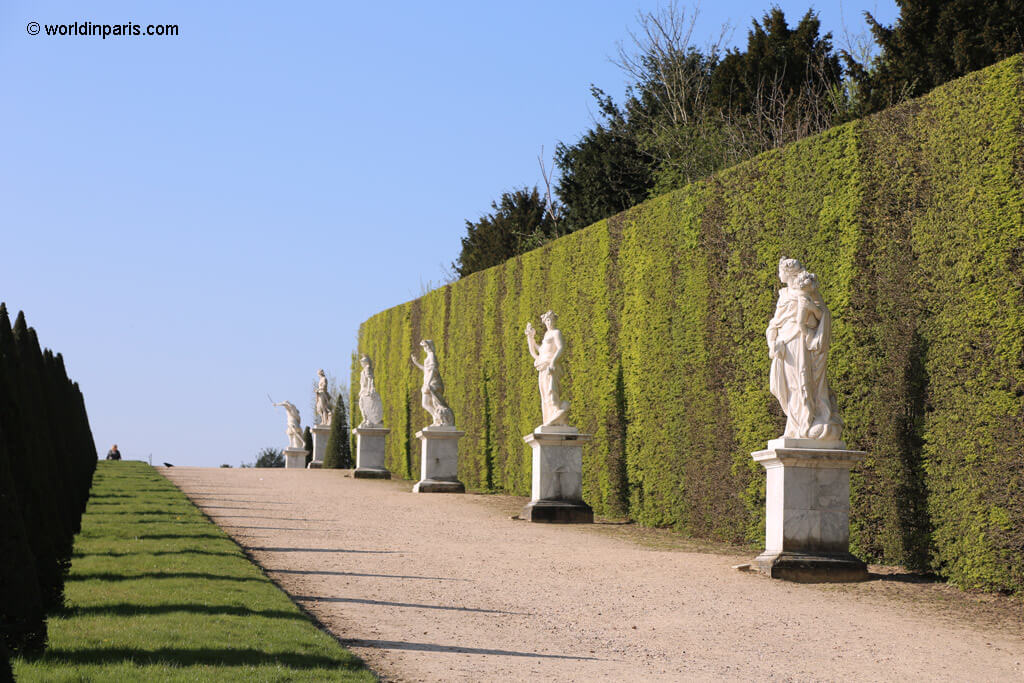
The King’s promenades in the gardens, especially in the Petit Parc, were incessant, and we know that he was delighted to show the Gardens of Versailles to his illustrious visitors, taking them personally around the parterres, displaying the extent of the views, and explaining the beauties of the sculptures and the fountains.
To visit the gardens, King Louis XIV imagined a tour guide, and he wrote it personally: La Manière de Montrer Les Jardins de Versailles (the Way to Show the Gardens of Versailles).
From the Palace of Versailles to the Apollo Fountain, this document is a guided tour description and a technical manual to manage the fountains’ water display. It especially allowed the hydrant men to open the fountains as visitors approached and close them as soon as the King and his visitors could not see them. One needed to be very close to the King to see the fountains work!
The King used to take this Royal Promenade on foot, or in his old age, in a small chariot. Often, these promenades would include a concert or a ballet in one of the grooves, a dinner served by lamplight, and the spectacle of firework illuminations by the Grand Canal.
The Fountains of Versailles
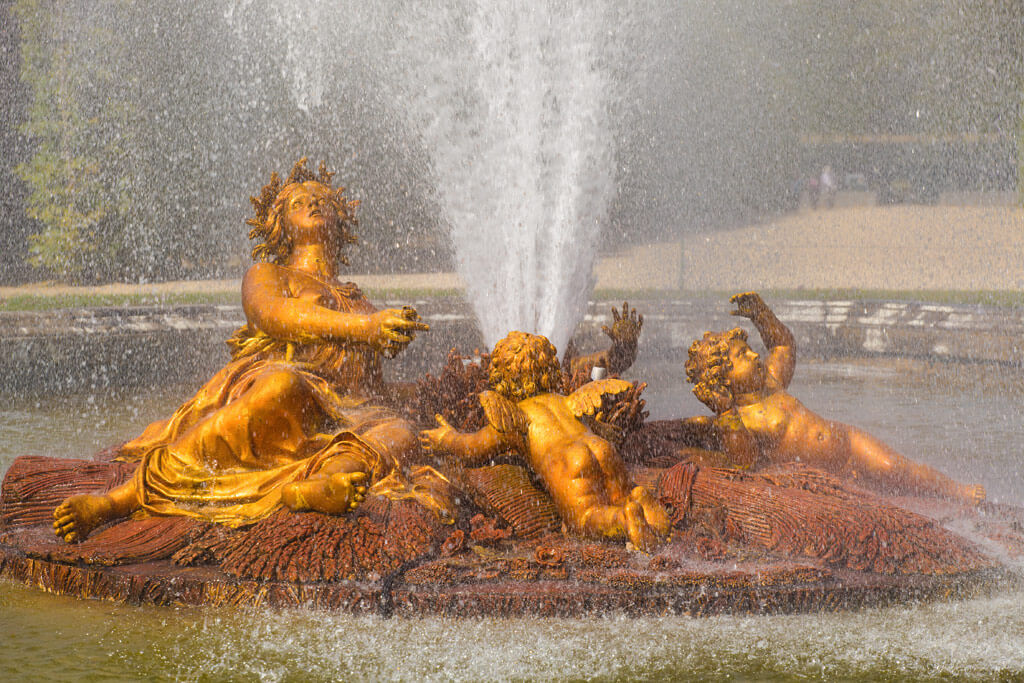
The Fountains of Versailles and other water features play an essential role in the Gardens of Versailles. They are part of the Gardens’ layout and decoration, but they are also a sensory pleasure, as the sound of running water is very relaxing.
In our opinion, the Gardens at Versailles without the fountains running is half of the fun, like a good meal without salt. So if you are going to visit Versailles only once in your life, do it during one of the Versailles Fountain shows to see the Versailles Gardens at its best.
Versailles Gardens Map and Top Sights
The Gardens at Versailles (the Petit Parc) surround the Château on three sides. The Versailles Gardens follow the French-style garden’s typology, an open system of axial pathways extending as far as the eye can see and punctuated with flowers and low hedges, flower beds, small streams, large lakes, and fountains.
In the Petit Parc, you will also find many Grooves. Grooves are delimited spaces (sometimes secluded spaces) designed as open-air saloons for court entertainment. These Grooves are adorned with fountains, vases, and statues, and they introduced an element of surprise or fantasy within the Gardens of Versailles.
Today, the Gardens of Versailles provide the perfect location for a stroll out of the capital. However, it takes quite a while to see the Versailles Gardens in detail, so it may be a good idea to have a plan of what areas you wish to visit.
These are, in our opinion, the top sights in the Gardens of Versailles, all marked on the Versailles Map here below. For the description of the fountains marked on this map of Versailles Gardens, check out our post on the Fountains of Versailles.
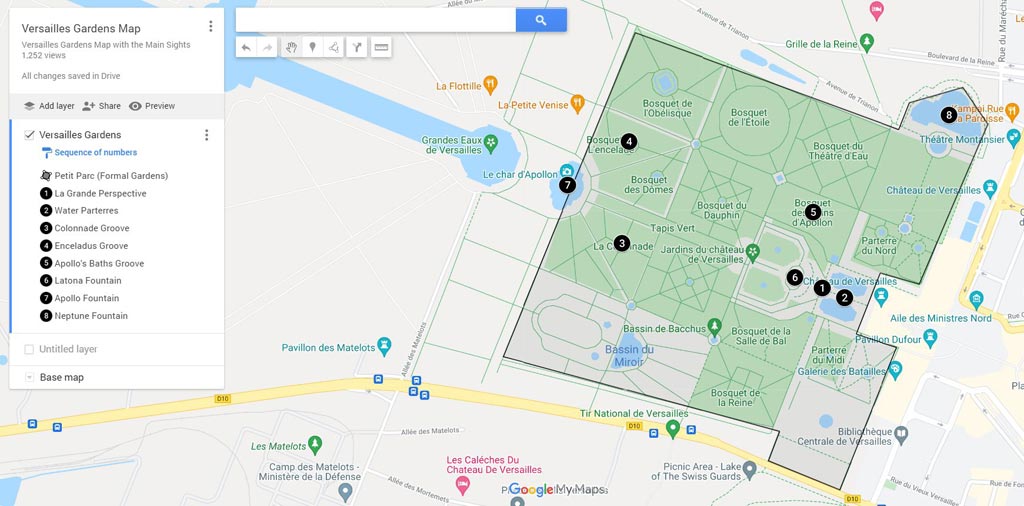
1. La Grande Perspective
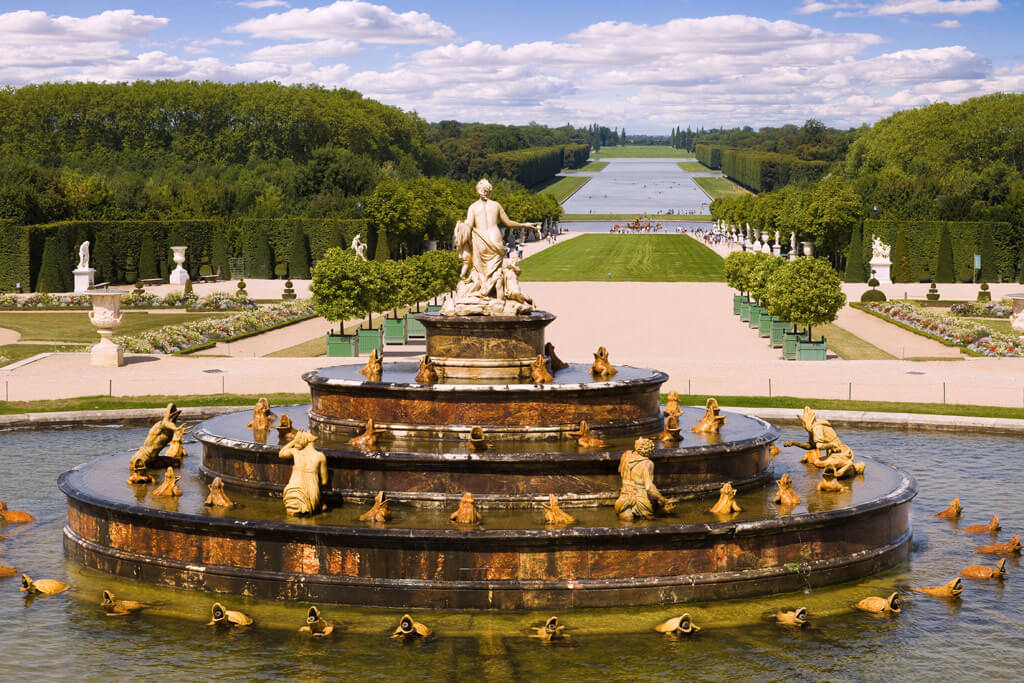
The grounds of Versailles are organized around two axes: north-south and east-west. The east-west axis is also known as La Grande Perspective.
The Grande Perspective starts at the Château de Versailles and goes through the water parterres (the two water basins at the foot of the Château), the Latona Fountain, the Royal Way, the Apollo Bassin, and the Grand Canal.
The Grand Canal’s layout at Versailles spans a very long distance (3 km) with a relatively little difference in level (30 m). The result is a flat vision with excessive optical shortening.
To compensate for the visual shortening of distant parts and achieve an impression of grandeur and dynamic balance, Le Nôtre used the technique of anamorphosis or metric distension: the further away the geometrical figures are, the longer and wider need to be. To do this, all the elements of this Grande Perspective are placed within two angular sectors that determine their design. The result is spectacular!
2. The Water Parterres
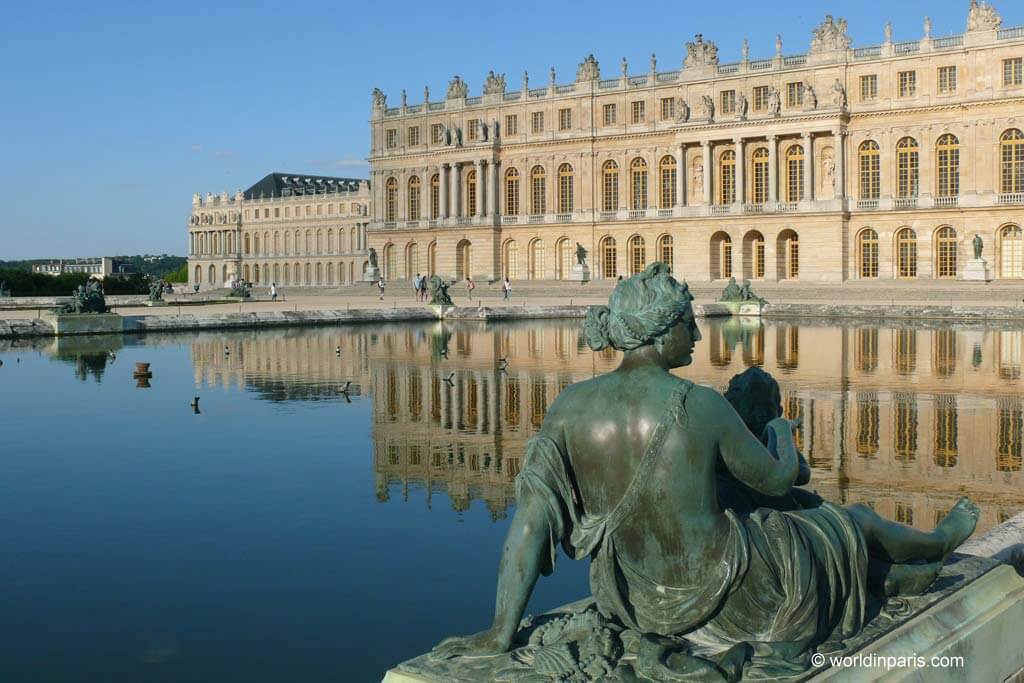
These water parterres at the foot of the Château have two water jets. Because these basins are visible from the Château, King Louis XIV wanted to see the water jets working all the time.
The basins are bordered by four groups of two sculptures representing the main French rivers and their tributaries.
3. The Colonnade Groove
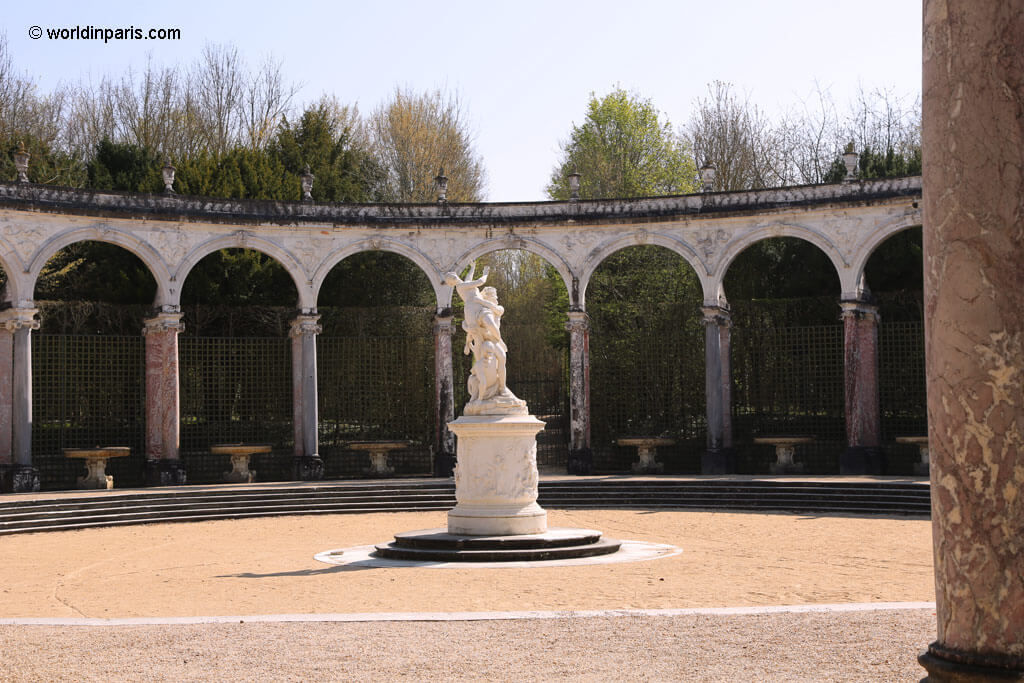
Designed by Mansart in 1684, this groove has marbles of different origins, and it is decorated with bas-reliefs representing musician kids. The sculpture in the center represents Persefone (Proserpine), kidnapped by the God Hades (Pluto).
When the fountains under the arcades are on, at the sound of Baroque music, the groove is spectacular to see and a refreshing place to be.
4. Enceladus Groove
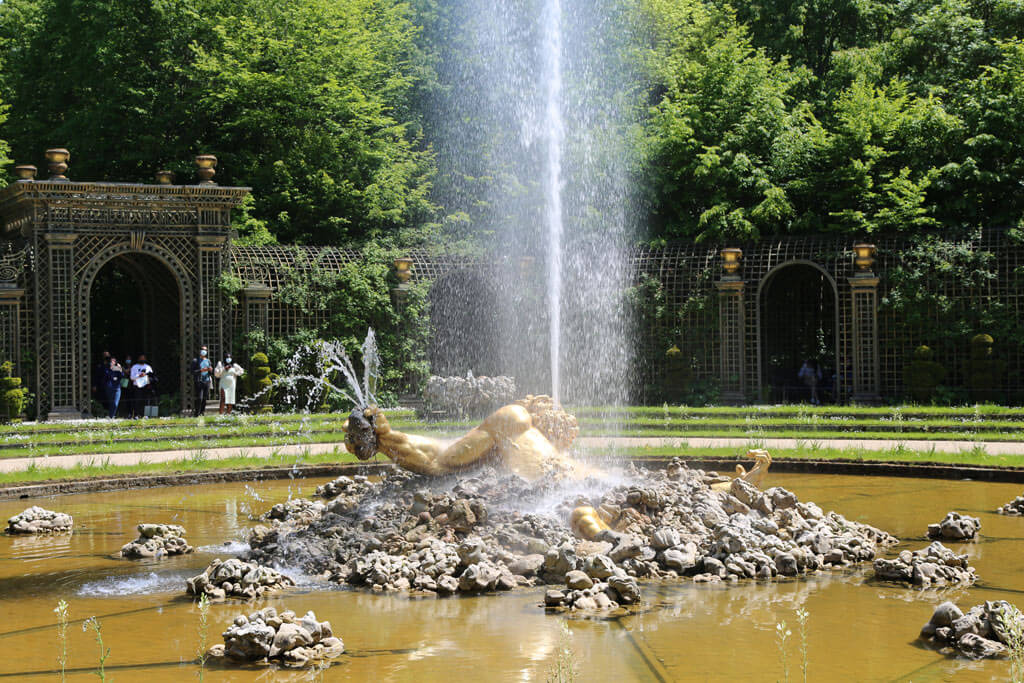
The Enceladus groove dates from 1675, and it represents the giant Enceladus buried under the rocks of Mount Olympus by the Gods he and his brothers had wished to dethrone. His suffering is captured by an impressive water jet of 23 meters, which springs from his mouth like a cry.
5. Apollo’s Bath
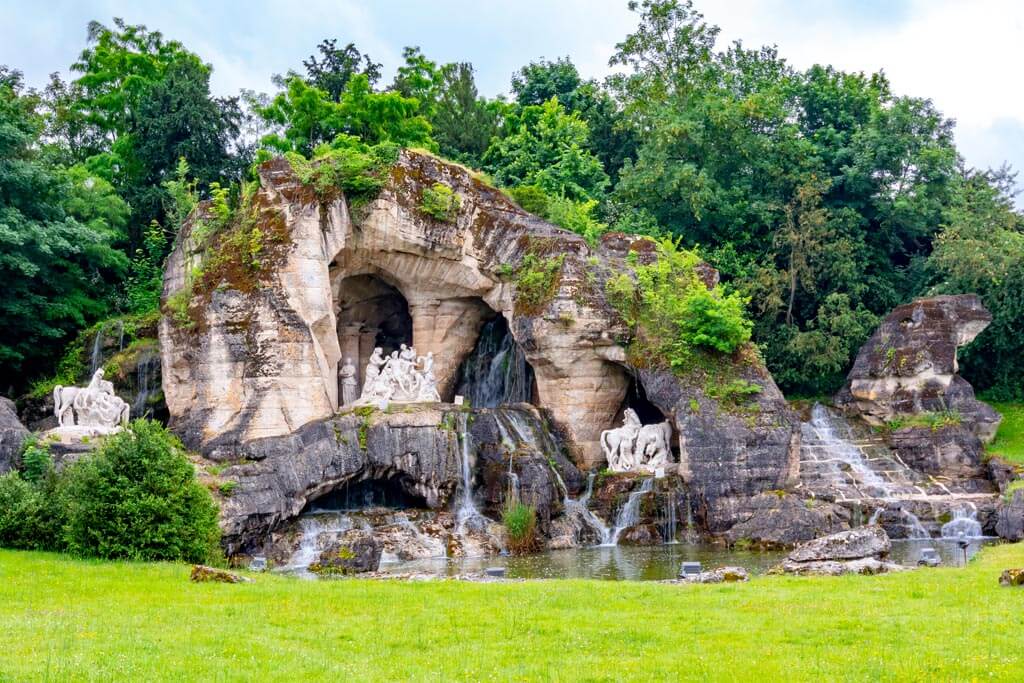
This is the most spectacular groove, and it was built during the reign of King Louis XVI between 1778 and 1781. Apollo’s Bath features three sculpture groups, and the scene represents the care provided to Apollo (the Sun God) and his horses after their daytime flight above the Earth.
And there you have it, the best of Versailles Gardens, the Versailles Shows, and the Gardens of Versailles map with the must-sees for a wonderful visit to Versailles.
Click here for more Versailles Posts
Pin it now & read it later
